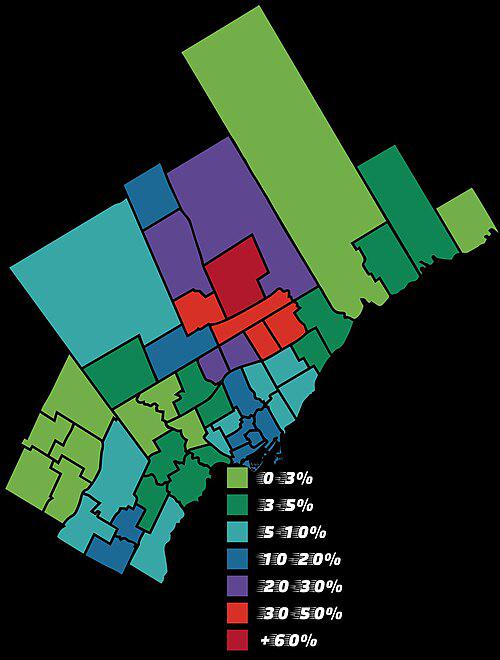Chinese Population Distribution Map in Greater Toronto Area


Marcus Rodriguez
Historical Geography Expert
Marcus Rodriguez specializes in historical cartography and geographic data analysis. With a background in both history and geography, he brings unique...
Geographic Analysis
What This Map Shows
This map provides an insightful visualization of the Chinese population distribution in the Greater Toronto Area (GTA) based on the 2021 Census Canada data. It highlights where Chinese communities are concentrated and illustrates their demographic significance in one of Canada's most multicultural cities. The map serves as a crucial tool for understanding not just where these populations live but also the broader social and economic implications of such distributions in urban planning, community services, and cultural integration.
Deep Dive into Chinese Population in the GTA
The Greater Toronto Area is renowned for its diversity, with over 50% of its residents identifying as part of a visible minority. Among these, the Chinese population stands out as one of the largest ethnic groups. According to the 2021 Census, approximately 13.5% of Toronto's population is of Chinese descent, making it a significant demographic force in shaping the city's cultural landscape.
Interestingly, the Chinese community in the GTA is not a monolithic group; it consists of various sub-ethnicities including Cantonese, Mandarin, and other dialect speakers. This diversity enriches the cultural tapestry of the area, contributing to Toronto's reputation as a global city. Chinese immigrants have settled in the GTA for decades, with significant waves occurring in the late 20th century due to socio-political changes in China and Hong Kong.
The map reveals that the highest concentrations of the Chinese population can be found in areas such as Markham, Richmond Hill, and parts of Scarborough. Markham, for example, is home to a vibrant Chinatown and numerous Chinese businesses, which serve as cultural hubs for the community. The presence of Chinese-language schools, cultural centers, and restaurants underscores the community's strong cultural identity and its desire to maintain connections to its heritage.
From a demographic perspective, the Chinese population in the GTA is relatively young, with a significant proportion of residents falling into the 25 to 44 age bracket. This youthful demographic is crucial as it contributes to the labor force, stimulates local economies, and fosters innovation in various sectors. Moreover, the education levels among the Chinese community are generally high, with many individuals holding university degrees and professional qualifications, which further enhances their economic contributions.
Regional Analysis
The map delineates distinct patterns based on various regions within the GTA. For instance, Markham has seen an explosive growth in its Chinese population, with the 2021 Census indicating an increase of over 30% since the last census in 2016. This growth can be attributed to the availability of housing, educational opportunities, and the establishment of businesses catering to the Chinese community.
Richmond Hill, another hotspot for Chinese residents, mirrors this trend, with a notable increase in the number of residents identifying as Chinese. The map indicates that these areas not only have a high population density of Chinese individuals but also feature numerous amenities and services tailored to their needs, such as Chinese supermarkets, restaurants, and cultural festivals.
In contrast, other parts of the GTA, such as downtown Toronto, show a more varied demographic mix with a smaller concentration of Chinese residents. However, significant numbers still exist in pockets, particularly in neighborhoods like East Chinatown. This area, with its blend of cultures, showcases the integration of Chinese heritage within the broader multicultural framework of the city, offering a fascinating juxtaposition of traditional and modern influences.
Significance and Impact
Understanding the distribution of the Chinese population in the Greater Toronto Area is vital for several reasons. Firstly, it informs urban planners and policymakers about community needs, allowing for the development of targeted services such as healthcare, education, and transportation that cater specifically to these populations.
Secondly, as the Chinese community continues to grow, its cultural influence on local traditions, culinary landscapes, and social dynamics becomes even more pronounced. From the Lunar New Year celebrations that draw thousands to the annual Toronto Chinese Lantern Festival, the vibrancy of this community is felt citywide.
Lastly, with current trends indicating a continued influx of immigrants from China, particularly in the wake of the global pandemic, projections suggest that the Chinese population in the GTA will keep growing. This growth will likely have significant implications for the economy, labor market, and cultural landscape of Toronto, making it essential for stakeholders to remain attuned to these changes for future planning and community integration efforts.
Overall, the Chinese population distribution map of the Greater Toronto Area is not just a reflection of numbers; it is a story of migration, adaptation, and the ongoing evolution of one of North America’s most diverse urban centers.
Visualization Details
- Published
- August 15, 2025
- Views
- 400
Comments
Loading comments...